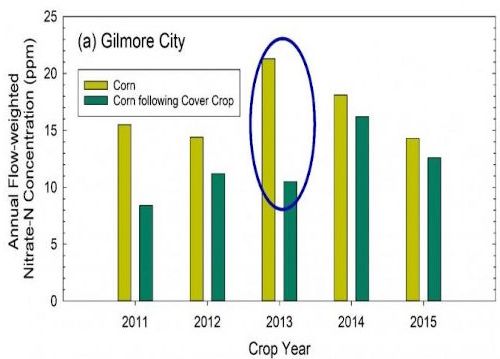By Matthew Helmers and Brian Dougherty et.al
The dry conditions throughout large areas of Iowa during 2020 reminds us of Iowa’s last significant drought in 2012 and the subsequent impacts on nitrate-N levels in subsurface drainage the following spring. This article will address concerns for water quality in drought conditions and opportunities to reduce nutrient losses from fields this fall.
There is a risk of elevated fall soil nitrate levels due to dry conditions this growing season. Dry conditions affect soil N cycling in several ways. Lack of soil moisture can reduce yields and thus N export from the field. It also reduces N cycling in the soil because microbial activity slows with lack of soil moisture. These factors can result in excess residual nitrate in the soil profile after fall harvest and the potential for substantial N leaching with late fall or spring precipitation.
At drainage water quality sites near Gilmore City, Iowa and the Northeast Research and Demonstration Farm near Nashua, IA an increase in nitrate-N concentrations in drainage water in 2013 was observed, regardless of which crop, corn or soybean, was planted in that growing season. Corn was planted in 2013 at Gilmore City and soybean at Nashua (Figures 1a and 1b). Prior research data has shown cover crops can be a very effective mechanism to reduce water quality impacts after drought years. At both sites the spike in nitrate-N levels was significantly reduced with the use of a winter cereal rye cover crop. Cereal rye was drilled after fall harvest and then allowed to grow the following spring until it was terminated before corn or soybean planting. Cover crops were terminated about two weeks before corn planting and immediately before soybean planting.
Cereal rye is particularly effective for scavenging residual N and cycling it through plant biomass. Data from Nashua shows N accumulation in aboveground rye biomass ranging from five to over 100 lbs N/ac depending on the year and cropping system. Oats, annual ryegrass, and oilseed radish are also effective N scavengers if established early enough to allow for fall growth.
There are a few things to consider when establishing a cover crop due to dry conditions this year. One is that crop harvest will likely be earlier than it has been in recent years due to early planting, fast maturation of the crop, and the derecho opening up some acres early. This may provide an opportunity to get a cover crop established and potentially get good growth this fall. However, that depends on precipitation timing and rates. Getting a cover crop established will be difficult with aerial and other broadcast seeding methods if it stays dry. Seeding with a drill provides better seed-to-soil contact and more reliable establishment in dry conditions. However, drilling requires waiting until after harvest so you will need to weigh the pros and cons of each option and decide if you are willing to risk surface application in dry areas. Cover crops can be beneficial to incorporate this fall to minimize the risk of nitrate-N loss when rainfall occurs.

Figure 1A. Annual nitrate-N concentration in the corn year at the Gilmore City Drainage Research Facility

Figure 1B. Annual nitrate-N concentration in the soybean year at the Northeast Research and Demonstration Farm
Source : iastate.edu